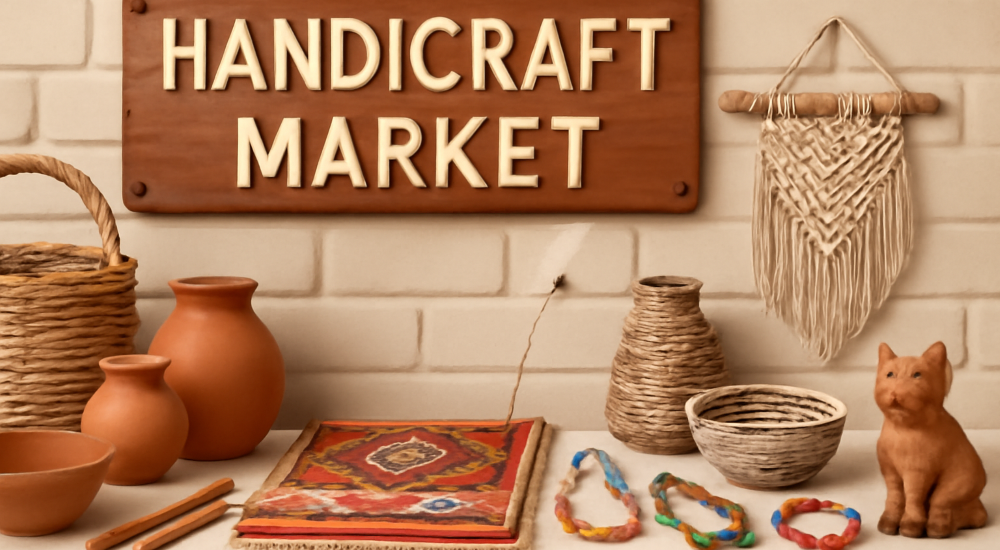The global handicraft market is witnessing an extraordinary resurgence. Once limited to small local markets and cultural festivals, handcrafted goods have now become a major force in the international economy. Valued at USD 427.71 billion in 2025, the market is projected to grow at a Compound Annual Growth Rate (CAGR) of 10.5%, reaching USD 1,160.83 billion by 2035.
This growth reflects a broader shift in consumer values, production models, and global trade patterns — a movement where tradition meets modern demand.
Discover Insights into the Market Request Your Sample Report! https://www.futuremarketinsights.com/reports/sample/rep-gb-18752
The Rise of Handmade in a Mass-Produced World
Handicrafts, by definition, are items made by hand using traditional methods, often passed down through generations. These can include textiles, pottery, jewelry, woodwork, leather goods, and woven products. In recent years, they have gained renewed attention as consumers seek alternatives to mass-produced goods.
Unlike industrial products, handmade goods carry cultural identity, craftsmanship, and a human connection. This individuality and authenticity have made them increasingly desirable in a marketplace crowded with standardized offerings.
Digital Platforms Fueling Global Reach
The digital economy has played a pivotal role in the transformation of the handicraft sector. E-commerce platforms such as Etsy, Amazon Handmade, and a growing number of regional marketplaces have enabled artisans to sell their products to a global audience. Social media has further amplified visibility, allowing craftspeople to promote their work directly to consumers and build global customer bases.
With digital tools, even artisans in remote areas can now connect with international buyers, receive direct payments, and track consumer preferences — all without leaving their communities.
Key Drivers of Market Growth
Several factors are contributing to the market’s expansion:
- Sustainable Consumption: Handicrafts are often made from locally sourced, renewable, or recycled materials. Their low environmental impact has positioned them as eco-friendly alternatives to factory-made goods.
- Cultural Appreciation: As global interest in diverse cultures grows, so does the demand for items that reflect heritage, symbolism, and traditional artistry.
- Tourism Revival: With international travel rebounding after the pandemic years, tourists are once again purchasing handcrafted souvenirs, art, and décor as part of their cultural experience.
- Interior Design Trends: Handcrafted products are increasingly featured in high-end design, contributing to the popularity of artisanal home décor, furniture, and lifestyle accessories.
- Corporate Responsibility: Businesses are opting for ethically sourced, handmade goods for gifting, branding, and office interiors to align with their sustainability and social responsibility initiatives.
Challenges Ahead
Despite the positive outlook, the sector faces challenges. Many artisans lack access to capital, formal training, or scalable infrastructure. Inconsistent income, market saturation, and competition from machine-made imitations also pose ongoing risks.
There is also a need for stronger international standards to protect traditional knowledge, ensure fair trade practices, and authenticate genuine handmade products in the global market.
Key Market Players
- Asian Handicrafts
- Fakih Group of Companies
- Laizhou Zhonghe Arts & Crafts Co. Ltd.
- Ten Thousand Villages
- Minhou Minxing Weaving Co. Ltd.
- The India Craft House
- Creative Expressions
- PT Harmoni Jaya Kreasi
- Gangga Sukta
- PT Fuzen Decor Bali
Top Segments Studied in the Handicraft Market Report
By Product:
The market includes woodworks, metal artworks, handprinted textiles & embroider goods, imitation jewelry, and others.
By End Users:
By end users, the market is divided into residential and commercial.
By Distribution Channel:
Handicrafts are sold through specialty stores, independent retailers, online stores, and others.
By Region:
The market spans across North America, Europe, Asia Pacific, the Middle East & Africa, and Latin America.
Buy the detailed market report now! https://www.futuremarketinsights.com/checkout/18752
About Future Market Insights (FMI)
Future Market Insights, Inc. (ESOMAR certified, recipient of the Stevie Award, and a member of the Greater New York Chamber of Commerce) offers profound insights into the driving factors that are boosting demand in the market. FMI stands as the leading global provider of market intelligence, advisory services, consulting, and events for the Packaging, Food and Beverage, Consumer Technology, Healthcare, Industrial, and Chemicals markets. With a vast team of over 400 analysts worldwide, FMI provides global, regional, and local expertise on diverse domains and industry trends across more than 110 countries.
Contact Us:
Future Market Insights Inc.
Christiana Corporate, 200 Continental Drive,
Suite 401, Newark, Delaware – 19713, USA
T: +1-347-918-3531
For Sales Enquiries: sales@futuremarketinsights.com
Website: https://www.futuremarketinsights.com
LinkedIn| Twitter| Blogs | YouTube






